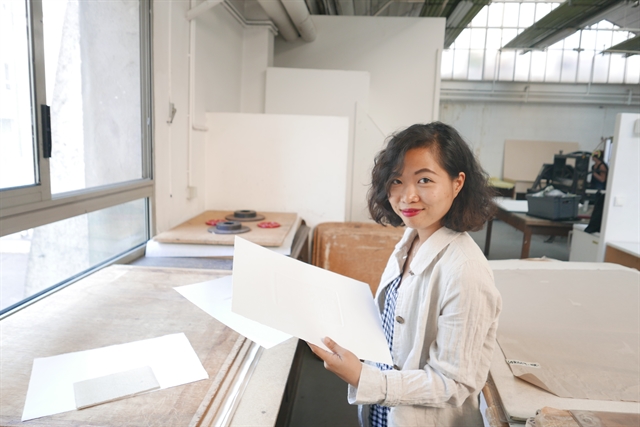An installation exhibition entitled Nước Xanh Non Biếc (Blue River Green Mountain) at the French cultural centre L'Espace is the result of artist Lê Giang's three-month residency at the Cité Internationale des Arts in Paris.
Việt Nam News reporter Nguyễn Bình interviews Giang about the ongoing exhibition.

Artist Lê Giang. Photo courtesy of the artist
Where did the name for the exhibition come from?
The name of the exhibition D'eau et de verdure in French or Nước Xanh Non Biếc in Vietnamese derives from a description used in a flyer to advertise the International Colonial Exhibition in 1931 which was held in Paris.
Promoters described the event as “tout le charme et le mystère de l'exotisme dans un admirable décor d'eau et de verdure,” an evocation that exemplifies French depictions of ‘exotic’ Indochina during this period.
My ongoing exhibition at L'Espace focuses on the representation of Việt Nam in international colonial exhibitions in France from 1907-1931.
During these colonial exhibitions, the French government brought people from the colonies to Paris and had them create native arts and crafts and perform in grandly scaled reproductions of their native architectural styles such as huts or temples with the hope that this would paint its colonial empire in a beneficial light, showing the mutual exchange of cultures and the benefit of France's efforts overseas.
All the artworks I created for the exhibition were based on the archives of these events. In this exhibition, I'm showing a printmaking series.
The main focal point is the đình - a communal village house which was commissioned in 1905 in Việt Nam, then shipped to France to serve as "Cochin-China pavilion” at the Colonial Exhibition of Marseilles in 1906 and as “Annamite house” at the 1907 Colonial Exhibition at the Jardin colonial of Nogent-sur-Marne Paris and later in 1920 converted into Temple du Souvenir Indochinois - a temple dedicated to the memory of Indochinese soldiers who “died for France” in World War I.
In exploring the archives of these events, I learned about the past through its material remains with the aim to recover and reconstruct the archive, to reveal how it shapes our relation to the past and the construction of historical meaning.
Photographic images were reproduced as a means of seeing issues of colonial power relations, Indochinese identities, the seduction of exoticism in France and the changing meanings of colonial power relations.
In these works, the embossing technique of artist Lê Bá Đảng was used to discolour and erase the details of the events, leaving the viewer traces of history.
Other works in the exhibition are a re-produced poster of the colonial exhibition in Marseille in 1922 and a sound installation room which consists of two printmaking artworks based on musical sheets, a musical box and a sound artwork.
What inspired you to do this exhibition?
This is my third solo exhibition. My first was at the Goethe Institute in Hà Nội and the second was at Vin Gallery in HCM City.
The exhibition at L'Espace in Hà Nội is an opportunity for me to show the results of my residency at Cite Internationale des Arts in Paris which is part of the Tương Hỗ (Support) Villa Saigon 2019 programme of the French Institute Việt Nam.
What did you get out of your residency?
The residency was a chance for me to be in Paris, travel and see art in Europe. During the three months, I found a new theme to work on and learnt a new technique to produce works.
I'm very grateful to have had fellow artists at Cite des Arts help me at the engraving workshop. Along with making artworks for the exhibition at L'Espace, I have shown new work on paper in ateliers collections, 24-25-26 mai 2019, autour de la 7éme FÊTE DE L'ESTAMPE at Cite des Arts.
At the exhibition, visitors will hear the French song La Petite Tonkinoise. Why did you use this song?
The sound of the installation room is a collaboration between me and sound artist Nhung Nguyễn based on the song La Petite Tonkinoise.
Written in 1906 by two French men who never actually came to Việt Nam, the song describes a French soldier and his northern Vietnamese lover.
The song eventually became hugely popular and was covered by Josephine Baker. To create the sound, we recorded a real La petite Tonkinoise, with a friend of mine singing and murmuring the song.
Some words in the lyrics were muted in this sound work. Through this work, I want to tell the story in that song through the voice of the girl.
During colonial times, in Việt Nam, women had no voices and were under the oppression of Vietnamese men and then the Western conquerors. Also, Indochina is often depicted as the image of a girl in Western literature.
What do you expect from the exhibition visitors?
All the works in the exhibition demand a close look and real attention from the visitors. If you only glance at the exhibition it might look like an empty room filled with blank pages.
That's what it's like if you think of a distant memory. Only when you really engage with the works can you see the details and the other side of history. VNS